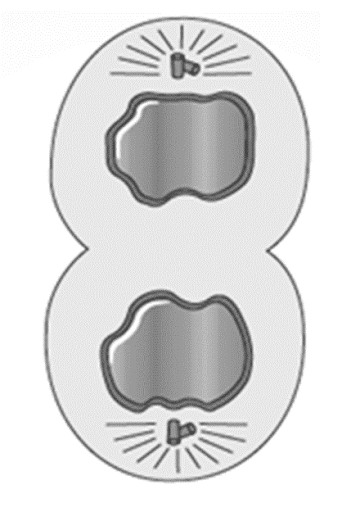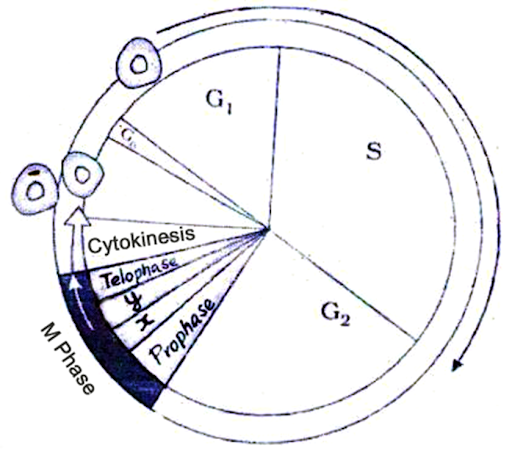CELL CYCLE AND CELL DIVISION
2020 MARCH
1. Observe the relationship between the first two terms and fill in the
blank. (1)
Metaphase: Spindle
fibres attach to kinetochores.
......................:
Chromatids move to opposite poles.
Answer: Anaphase
2. Analyse the table given below and fill in the blanks.
|
(A) |
(B) |
|
Zygotene |
....... (a)
........ |
|
....... (b)
........ |
Crossing over |
|
....... (c)
........ |
Dissolution
of synaptonemal complex |
|
Diakinesis |
....... (d)
........ |
Answer:
(a) Synapsis
(b) Pachytene
(c) Diplotene
(d) Terminalisation of chiasmata.
2019 JULY IMPROVEMENT
1. Crossing over occurs in ............ substage of Prophase-I.
a. Leptotene b. Zygotene
c. Diplotene d. Pachytene
Answer: d.
Pachytene
2. Given below is the diagrammatic representation of a particular stage of
mitosis:
a. Identify the stage.
b. Write any two features of this stage. (2)
Answer:
(a) Anaphase
(b) Centromere split and
chromatids separate.
Chromatids
move to opposite poles.
2019 MARCH
1. Fill in the blank.
Cytokinesis in
animal cell takes place by the appearance of a ................... in the
plasma membrane.
Answer:
Cleavage furrow.
2. Karyokinesis of mitosis is divided into 4 stages. Name the second and
third stage. Write any two features of second stage.
Answer:
Second stage:
Metaphase.
Third stage:
Anaphase.
Features of second stage (Metaphase): All chromosomes at equator. Chromosomes at maximum
condensation.
2018 JULY IMPROVEMENT
1. Observe the given stage of mitosis.
Identify the stage
and write any two features of it.
Answer:
Telophase.
Features: Chromosomes cluster at opposite poles. Reforms nuclear envelope.
2018 MARCH
1. First phase of meiosis I is typically longer and complex one. Name it.
Mention the five subdivisions of this Phase. (3)
Answer:
Prophase I.
Leptotene, Zygotene, Pachytene, Diplotene, Diakinesis.
2. Certain stages in cell cycle are given
below. (3)
Karyokinesis,
prophase, cytokinesis, metaphase, anaphase, telophase.
Choose the statements (from those given below) that match
with these stages and prepare a table.
· Centromere split
and chromosomes move to opposite poles.
· Chromosomes cluster
at opposite poles and nuclear envelope assembles around.
· Chromosomes seems
to be with two chromatids attached at centromere.
· Chromosomes
arranged at spindle equator.
· Separation of daughter
chromosomes.
· Division of
cytoplasm.
Answer:
|
Anaphase
/ karyokinesis |
Centromere
splits and chromosomes move to opposite poles. |
|
Telophase
/ Karyokinesis |
Chromosomes
cluster at opposite poles and nuclear envelope assembles around. |
|
Prophase
/ Metaphase / karyokinesis |
Chromosomes
seems to be with two chromatids attached at centromere. |
|
Metaphase
/ karyokinesis |
Chromosomes
arranged at spindle equator. |
|
Anaphase
/ karyokinesis |
Separation
of daughter chromosomes |
|
Cytokinesis |
Division
of cytoplasm |
2017 JULY (IMPROVEMENT)
1. "Meiosis is highly significant in
sexually reproducing organisms". Justify. (2)
Answer:
It ensures the conservation of specific chromosome number.
It creates genetic
variation.
2. Give the scientific term of the
following.
a) Interchange of
genetic material between non-sister chromatids of homologous chromosomes. (1)
Answer: a)
Crossing over.
2017 MARCH
1. Given below is the metaphase of
mitosis. Analyze the diagram and draw a sketch of anaphase. Write any two
events of anaphase. (3)
Answer: Anaphase.
Two events of anaphase:
· Centromere of each chromosome divides longitudinally resulting
in the formation of two daughter chromatids.
· As the spindle fibres contract, the chromatids move from the
equator to the opposite poles.
2016 MARCH
1.
a) identify the substages of meiosis in
which crossing over is occurring.
i) Leptotene ii) Zygotene
iii) Pachytene iv) Diplotene
b) Summarize the significance of meiosis in sexually
reproducing organisms. (3)
Answer:
a) Pachytene
b) 1) Meiosis
conserves the specific chromosome number of each species across generations in sexually reproducing
organisms.
2)
It results in reduction of chromosome number by half.
3) It
increases the genetic variability from one generation to the next.
4) Variations are very important
for the process of evolution.
2015 SEPTEMBER (IMPROVEMENT)
1. Observe the diagram related with cell cycle.
Identify and describe A, B and C in the diagram. (3) (Hint: Description of
one point each from A, B and C).
Answer:
A= G1 phase
B= S phase
C= G2 phase
a.
G1 phase: First growth phase. Continuous growth of cell.
b.
S (Synthetic) phase: DNA replication takes place.
c.
G2 phase (Gap 2): Second growth phase. Cell growth continues.
OR
Write five sub-stages in prophase-I of meiosis. Point out in which
sub-stage crossing over occurs.
Answer:
5 substages of Prophase I: Leptotene, Zygotene, Pachytene, Diplotene
& Diakinesis.
Crossing over occurs in
Pachytene (Pachynema) stage.
2015 MARCH
1. Observe the diagrammatic view of a cell cycle and answer the questions:
a.
Identify the phase in which DNA synthesis takes place. (1)
b.
Mention any one event that takes place in the stages marked as 'x' and
'y'. (2)
Answer:
a) S phase.
b) x=
Metaphase. Chromosomes come to lie at the equator.






